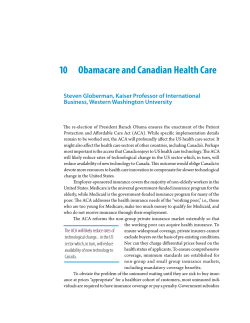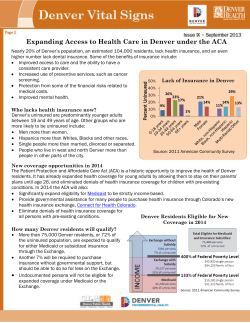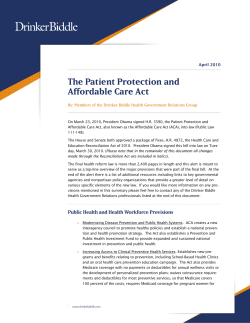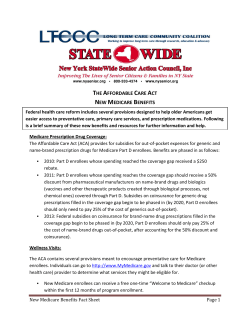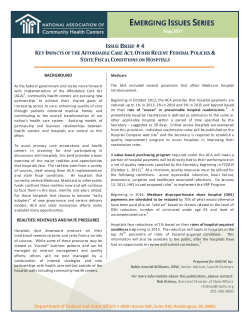
By Experts and stakeholders agree the current health care system is... Transforming Health Care Delivery
Transforming Health Care Delivery By Jane Hyatt Thorpe and Teresa Cascio Background Experts and stakeholders agree the current health care system is unsustainable. By 2020, health care spending will comprise almost 20% of the gross domestic product.1 Furthermore, an ever growing body of evidence clearly indicates that the system is not experiencing improvements in quality that are reflective of the cost growth.2 The Patient Protection and Affordable Care Act (ACA) takes significant strides towards the transformation of the American health care delivery system from a system that rewards volume to a system that rewards quality and value.3 The programs and initiatives authorized by the ACA hold the potential to reduce the rate of cost growth and improve the quality of care delivery through more coordinated care delivery models and reimbursement methods that reward coordinated care. These programs include financial and non-financial incentives for provider performance and new payment and care delivery models that foster care coordination across settings of care. This Implementation Brief explores the provisions in the ACA that support this transformation. Changes made by the ACA (§§ 2602, 2703, 3001, 3006, 3007, 3021, 3022, 3025, 3502)4 Medicare Shared Savings Program (MSSP).5 The MSSP provides incentives for health care providers to organize into Accountable Care Organizations (“ACOs”) as a means of providing coordinated, quality care to Medicare beneficiaries at a reduced cost. ACOs that meet quality performance benchmarks while saving costs may share in the savings. The ACA grants the Secretary of Health and Human Services (HHS) discretion to include electronic health record and electronic prescribing requirements in the MSSP. Patient-Centered Medical Homes.6 The ACA authorizes funding for the creation of “health teams” that will support primary care providers and patient-centered medical homes. Methods of support 1 Centers for Medicare and Medicaid Services, Office of the Actuary, National Health Statistics Group, National Health Care Expenditures Data, January 2012. 2 See Fisher, Elliott; Goodman, David; Skinner, Jonathan; Bronner, Kristen; “Health Care Spending, Quality and Outcomes: More Isn’t Always Better,” Dartmouth Atlas Project Topics Brief, February 27, 2009; McGlynn, Elizabeth A.; Asch, Steven M.; Adams, John; Keesey, Joan; Hicks, Jennifer; DeCristofaro, Alison; Kerr, Eve A; “The Quality of Health Care Delivered to Adults in the United States,” 348 New Eng. J. Med. 2635-45 (2003); Wennberg, John E.; Brownlee, Shannon; Fisher, Elliot S.; Skinner, Jonathan S.; Weinstein, James N.; “Improving Quality and Curbing Health Care Spending: Opportunities for the Congress and the Obama Administration” Dartmouth Atlas White Paper (2008); and de Brantes, François; Rosenthal, Meredith; Painter, Michael; “A Bridge from Fragmentation to Accountability — The Prometheus Payment Model,” N Engl J Med 2009; 361:1033-1036 (September 10, 2009). 3 Patient Protection and Affordable Care Act (Pub. L. 111-148) §3013 (2010). 4 Patient Protection and Affordable Care Act (Pub. L. 111-148) (2010) [HEREINAFTER “ACA”]. 5 ACA § 3022. 6 ACA § 3502. www.healthreformgps.org include: (1) offering care coordination, care transition, disease management, and disease prevention services; (2) collecting and reporting quality data; and (3) facilitating EHR implementation that meets the Health Information Technology for Economic and Clinical Health Act’s (“HITECH”) “meaningful use” requirements. State Option to Provide Health Homes for Enrollees with Chronic Conditions.7 States may offer health home services to Medicaid enrollees with a mental health condition, a substance use disorder, asthma, diabetes, heart disease, or obesity. The ACA defines health home services as including care management, care coordination, transitional care, and patient and family support services linked together by the use of health information technology. Hospital Readmissions Reduction Program (HRRP).8 The HRRP imposes a financial penalty on hospitals that have high readmission rates for conditions specified by the HHS Secretary. Value-based Purchasing Programs.9 The Secretary must implement value-based purchasing programs for Hospitals, Skilled Nursing Facilities, and Home Health Agencies and establish a value-based payment modifier for physicians and physician groups that will adjust Medicare payments to these providers based upon their performance on specified quality measures. The Center for Medicare and Medicaid Innovation and the Federal Coordinated Health Care Office.10 The ACA establishes the Center for Medicare and Medicaid Innovation (CMMI) and the Federal Coordinated Health Care Office (FCHCO) within CMS. CMMI will test the effect of innovative payment and delivery models focused on improving quality and reducing cost through more coordinated care delivery. FCHCO will work to align Medicare and Medicaid benefits and improve state and federal coordination when distributing benefits to dual eligible beneficiaries. Implementation Medicare Shared Savings Program (MSSP).11 CMS finalized MSSP regulations regarding ACO organization, quality measurement, quality reporting, and beneficiary attribution in November 2011. CMS began administering the first performance period in April 2012 with 27 ACOs participating.12 An additional 89 ACOs joined the MSSP for the second performance period on July 1, 2012. 7 ACA § 2703. ACA § 3025. 9 ACA §§ 3001, 3006, 3007. 10 ACA §§ 3021, 2602. 11 ACA § 3022. 12 CMS, Program News and Announcements, https://www.cms.gov/Medicare/Medicare-Fee-for-ServicePayment/sharedsavingsprogram/News.html (last visited Oct. 15, 2012). 8 www.healthreformgps.org Patient-Centered Medical Homes.13 CMS has yet to announce the availability of funding to establish patient-centered medical homes. State Option to Provide Health Homes for Enrollees with Chronic Conditions.14 Missouri, New York, Oregon, and Rhode Island have exercised their option to provide health homes for Medicaid enrollees with chronic conditions. CMS will continue to accept State Plan Amendments from other states that wish to exercise the option.15 Hospital Readmissions Reduction Program (HRRP).16 CMS began administering the HRRP on October 1, 2012. Hospitals that report excessive readmission rates for Medicare patients with Acute Myocardial Infarction, Pneumonia, and Heart failure will have their IPPS patient reduced by a maximum of 1%. The maximum reduction will rise to 2% in 2014 and 3% in 2015. Value-based Purchasing Programs.17 CMS finalized regulations for the hospital value-based purchasing program, effective October 1, 2012, and the physician value-based payment modifier, which will begin with the 2013 performance period. CMS submitted plans to Congress in 2012 regarding implementation of the skilled nursing facility and home health agency value-based purchasing programs, but has yet to propose rules for implementing these programs.18 Center for Medicare and Medicaid Innovation and the Federal Coordinated Health Care Office.19 o Bundled Payments for Care Improvement Initiative. Providers participating in this CMMI Initiative will receive bundled payments for acute and/or post-acute care services and may share any gains that result from providing coordinated and better quality care. o Financial Alignment Initiative (FAI). The FAI, administered by CMMI and FCHCO, will allow CMS to enter into three-way contracts with States and health plans whereby health plans will receive a capitated payment to provide coordinated care to dual eligible beneficiaries. The capitated payment should allow both CMS and State Medicaid Programs to achieve cost savings. The FAI also permits CMS to contract with States in a “managed fee for service” model. States participating in this model will receive a financial incentive to reduce the cost 13 ACA § 3502. ACA § 2703. 15 CHARLES TOWNLEY AND MARY TAKACH, NATIONAL ACADEMY FOR STATE HEALTH POLICY, DEVELOPING AND IMPLEMENTING THE SECTION 2703 HEALTH HOME STATE OPTION: STATE STRATEGIES TO ADDRESS KEY ISSUES 5 (2012), available at http://www.nashp.org/publication/developing-and-implementing-section-2703-health-home-state-option. 16 ACA § 3025. 17 Medicare and Medicaid Programs: Hospital Outpatient Prospective Payment; Ambulatory Surgical Center Payment; Hospital Value-Based Purchasing Program; Physician Self- Referral; and Patient Notification Requirements in Provider Agreements, 77 FED. REG. 74122, 74527 (Nov. 30, 2011); Medicare Program; Revisions to Payment Policies Under the Physician Fee Schedule, DME Face-to-Face Encounters, Elimination of the Requirement for Termination of Non- Random Prepayment Complex Medical Review and Other Revisions to Part B for CY 2013, 77 FED. REG. 68892, 69306 (Nov. 16, 2012). 18 U.S. DEPT. OF HEALTH AND HUMAN SERVICES, REPORT TO CONGRESS: PLAN TO IMPLEMENT A MEDICARE HOME HEALTH AGENCY VALUE-BASED PURCHASING PROGRAM (2012); U.S. DEPT. OF HEALTH AND HUMAN SERVICES, REPORT TO CONGRESS: PLAN TO IMPLEMENT A MEDICARE SKILLED NURSING FACILITY VALUE-BASED PURCHASING PROGRAM (2012). 19 ACA §§ 2602, 3021. 14 www.healthreformgps.org and improve the quality of both Medicare and Medicaid services. CMS has received FAI proposals from 26 States and entered into a memorandum of understanding with Massachusetts (capitated model) and Washington (Managed Fee-for-Service Model) regarding implementation of the Initiative.20 o Pioneer ACOs.21 CMMI’s Pioneer ACO Model Initiative is a high-risk, high-reward alternative to the MSSP. During the first two years of the Initiative, participating ACOs that reduce costs will receive shared savings. ACOs that meet the shared savings requirements will then transition to a population-based payment model during the third year of the Initiative and may continue to receive this population-based payment during optional fourth and fifth years. 32 ACOs are currently participating in the Initiative. Key Issues HIT Implementation22. Health care providers must utilize health information technology (“HIT”) in order to exchange health information efficiently, but barriers such as cost and interoperability may have caused health care providers to delay implementation. Existing implementation incentives, such as the meaningful use program created by HITECH, may not completely cover the costs and are not available to all providers (e.g. long-term care facilities). Additionally, providers may delay implementation of an ACO until more systems are fully interoperable in order to avoid replacing or upgrading their existing system. These concerns coupled with other financial concerns may limit the number of organizations that become ACOs. Privacy. Patients and providers may be concerned about the privacy and security of health information as the use of HIT to coordinate care becomes more prevalent in the health care system. Congress increased privacy and security protections for health information in HITECH, but the number of reported breaches since 2008 indicates that such protections may not be enough.23 Patient Engagement and Understanding. The Medicare and Medicaid amendments in the ACA seek to align the programs and increase beneficiaries’ ability to participate in their care. However, implementing these changes may confuse beneficiaries as they find themselves eligible for a “health home” or assigned to an “ACO.” CMS and states ensure beneficiaries understand the benefits and opportunities of these programs to alleviate beneficiary concerns about their changing care and increase participation in optional programs. 20 CENTERS FOR MEDICARE & MEDICAID SERVICES, SMDL #11-008, FINANCIAL MODELS TO SUPPORT STATE EFFORTS TO INTEGRATE CARE FOR MEDICARE-MEDICAID ENROLLEES (2011). 21 CMMI, Pioneer ACO Model, www.inovations.cms.gov/initiatives/aco/pioneer/ (last visited Nov. 26, 2012). 22 See THE COMMONWEALTH FUND, SHANA LIEBERMAN KLINGER AND SCOTT WHITE, LESSONS FROM A HEALTH INFORMATION TECHNOLOGY DEMONSTRATION IN NEW YORK NURSING HOMES (2010). 23 The U.S. Department of Health and Human Services maintains a database of security breaches that affect more than 500 individuals. The database currently lists over 500 records with the largest breach affecting almost 5 million people. HHS, Breaches Affecting 500 or More Individuals, http://www.hhs.gov/ocr/privacy/hipaa/administrative/breachnotificationrule/breachtool.html (last visited Nov. 26, 2012) www.healthreformgps.org Quality Reporting Burden. Health care providers that submit quality data pursuant to a valuebased purchasing program may also be submitting quality data for other CMS programs (e.g. the Physician Quality Reporting System). This places an administrative burden on providers as the reporting methods and measures used in these programs do not perfectly align. CMS is working to align the various programs in the future.24 Beneficiary attribution. Medicare and Medicaid enrollee attribution is a fundamental part of ACA programs and demonstrations (e.g. MSSP and FAI). These programs and demonstrations will draw from the same enrollee population. CMS must ensure the fair attribution of enrollees since the number and health status of enrollees will affect provider payments and demonstration outcomes.25 In addition, the inability to require patients to remain with an ACO may compromise an ACO’s ability to demonstrate savings. Authorized Funding State Option to Provide Health Homes for Enrollees with Chronic Conditions.26 CMS may award an aggregate of $25 million in planning grants to 10 states to help with their design and implementation of health homes. Center for Medicare and Medicaid Innovation. The ACA authorizes $5 million for the design, testing, and evaluation of payment and delivery models. CMMI may receive $10 billion for activities conducted between 2011-2019 and an additional $10 billion for CMMI activities conducted during each subsequent 10 year period.27 24 Medicare Program; Hospital Inpatient Prospective Payment Systems for Acute Care Hospitals and the Long- Term Care Hospital Prospective Payment System and Fiscal Year 2013 Rates; Hospitals’ Resident Caps for Graduate Medical Education Payment Purposes; Quality Reporting Requirements for Specific Providers and for Ambulatory Surgical Centers, 77 FED. REG. 28032 (May 11, 2012). 25 See Memorandum of Understanding Between The Centers for Medicare & Medicaid Services and The State of Washington 10, available at https://www.cms.gov/Medicare-Medicaid-Coordination/Medicare-and-Medicaid-Coordination/Medicare-MedicaidCoordination-Office/FinancialModelstoSupportStatesEffortsinCareCoordination.html. 26 ACA § 2703. 27 ACA § 3021(a). www.healthreformgps.org
© Copyright 2025

